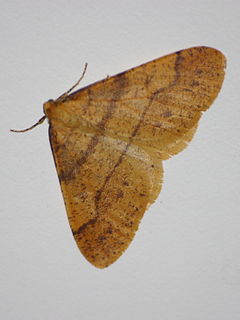
Heteropsis adolphei, the red-eye bushbrown, is a species of satyrine butterfly found in southern India. The species name is after Adolphe Delessert who collected the first specimens based on which the species was described.

Troides haliphron, the haliphron birdwing, is a birdwing butterfly confined to Sulawesi and the lesser Sunda Islands.

Plagodis pulveraria, the barred umber, is a moth of the family Geometridae. The species was first described by Carl Linnaeus in his 1758 10th edition of Systema Naturae. It is found throughout much of the Palearctic realm from Ireland to Japan, and in the Nearctic realm (Canada).

Agriopis aurantiaria, the scarce umber, is a moth of the family Geometridae. It was first described by Jacob Hübner in 1799 and it is found throughout Europe from Spain through Central Europe to Russia. In the south it can be found from the western Mediterranean to the Black Sea and the Caucasus. Its northern distribution reaches as far as central Fennoscandia. The species can be found in many different places, including deciduous forests, orchards, gardens as well as parks and settlement areas.

Philereme transversata, the dark umber, is a moth of the family Geometridae. It is found in much of the Palearctic realm.
Calamotropha atkinsoni is a moth in the family Crambidae. It was described by Philipp Christoph Zeller in 1863. It is found in south-east Asia, where it has been recorded from India, Sri Lanka, Thailand, Singapore and Sulawesi.
Roxita adspersella is a moth in the family Crambidae. It was described by Pieter Cornelius Tobias Snellen in 1893. It is found in Sri Lanka.
Trischistognatha limatalis is a moth in the family Crambidae. It is found in Costa Rica.
Aureopteryx argentistriata is a moth in the family Crambidae. It is found from central Mexico south to Paraguay, Brazil and Trinidad. The habitat consists of lowland areas.
Cliniodes malleri is a moth in the family Crambidae. It was described by Eugene G. Munroe in 1964. It is found in southern Brazil.
Bocchoris manuselalis is a moth in the family Crambidae. It was described by Rothschild in 1915. It is found on Seram.
Compsoctena secundella is a moth in the Eriocottidae family. It was described by Walsingham in 1897. It is found in the Central African Republic and Sierra Leone.
Drepanojana is a monotypic moth genus in the family Eupterotidae. Its single species, Drepanojana fasciata, is found in Ghana, Nigeria and Sierra Leone. Both the genus and species were described by Per Olof Christopher Aurivillius in 1893.
Papuapterote styx is a moth in the family Eupterotidae. It was described by George Thomas Bethune-Baker in 1908. It is found in New Guinea.
Hemijana variegata is a moth in the family Eupterotidae. It was described by Rothschild in 1917. It is found in Mozambique.
Dichomeris renascens is a moth in the family Gelechiidae. It was described by Walsingham in 1911. It is found in Mexico (Tabasco).
Dichomeris rubiginosella is a moth in the family Gelechiidae. It was described by Francis Walker in 1864. It is found in Mexico, Peru and Amazonas, Brazil.
Dichomeris evitata is a moth in the family Gelechiidae. It was described by Walsingham in 1911. It is found in Panama.
Dichomeris eurynotus is a moth in the family Gelechiidae. It was described by Walsingham in 1897. It is found in the Central African Republic and Sierra Leone.
Haplochela trigonota is a moth in the family Gelechiidae. It was described by Walsingham in 1911. It is found in Mexico, Panama, Guyana and Brazil.




